QuestionQUESTION: My boyfriend and I decided to set up our first big tank. We got a 45 gallon corner tank and spent two days setting it up with gravel, lots of fake plants large and small, a huge ship with a ton of hiding places and built in caves inside, fake coral, you name it. We got an aquaclear 70 gallon bio-filter, a 55 gallon air pump, nice heater/thermometer etc. We made out a list of the fish we would eventually (EVENTUALLY!!) want in the tank. The final list was:
1 Gold Gourami
1 Pearl Gourami
1 female paradise fish
6 tiger barbs
1 rainbow shark
1 leopard pleco
1 tiger pleco
3 leopard cory
We set the tank up on Thursday of last week, added a handful of gravel from out 4 year old established 10 gallon and let it run for the weekend. Then following our local fish specialist store's advice, we added 4 tiger barbs to start cycling. Then- I went out of town and left my extremly excited boyfriend in charge of the tank.
When I got home today, I found he had unexpectedly gone shopping using our fish list! Now we have
6 tiger barbs
1 gold gourami
1 pearl gourami
1 rainbow shark
1 paradise fish
HELP!!!! I know thats WAY too much fish. I don't have a second tank to split them up, and the fish store we get our fish from will not take fish back once you put them in your home tank. The fish were active and seemed perfectly happy- the water was crystal clear, but then I tested it. PH was at 7, Nitrites were non existant, but the Nitrates were at 5 and the ammonia was at 1.0!!! I did a 20% water change and added an ammonia remover insert to the filter but I dont know what else to do.
Is it possible to cycle with 10 fish in a 45 gallon tank? Even if I have to do 50% water changes every day for 2 weeks? What can I do? I really want to fix this versus put some "free fish to good homes" adds up, but if thats what it takes I will do that too.
Thanks for any help!!!
ANSWER: Hi Shawn,
I do understand! It's hard for people to resist putting fish in an empty tank. Besides, it's not like you can see that bacteria anyway - people look at me like I'm crazy when I tell them that this invisible stuff is going to colonize their tank, and that it's this invisible stuff (not the carbon) that is going to be making the water safe for their fish. (Along with using tap water dechlorinator, of course.)
If you can manage 50% water changes daily for 2 weeks, everything should be fine. You'll be able to dilute most of the ammonia. I wouldn't use the ammonia remover insert, because you need all the space you can get in your filter for biological media! I would use two sponges plus one Biomax insert. (The Biomax insert goes on top, the two sponges go on the bottom.) The foam sponges perform mechanical filtration (removing the particles of waste from your tank) but will eventually colonize with beneficial bacteria and perform biological filtration also. The Biomax performs mostly just biological filtration - it's supposed to have a huge surface area for colonizing bacteria - but it's this that's most important in a fish tank. Once it colonizes with beneficial bacteria, it is important that you do not replace it - instead, just rinse it with warm dechlorinated water (or water from the tank) to get the gunk out.
The only trouble I see you in for, is that gouramis can be territorial with each other. I have a male and female pearl gourami and they get along most of the time, but if I had one gold gourami and one pearl gourami, I doubt this would be the case! The gold gouramis are just a color variant of the three-spot gourami (which is blue, with black spots) and that's Trichogaster trichopterus, which is a species that gets mean as it gets older. You have a big school of tiger barbs, so hopefully they'll keep any nipping to themselves, but do know they are considered classic nippers...and the long fins of the gouramis might tempt them! I do think that a school of 6-8 tiger barbs ought to keep them busy with each other and their own hierarchy, though.
You picked really hardy species, the least hardy of all of these is the pearl gourami, and it is still fairly hardy. If you can just manage to do daily water changes (do your best - changing out this much water can get taxing after a while!) you really ought to be ok. Make sure you have that air pump up full blast, the aeration seems to help the fish cope with a cycling tank a bit better. You could also use a bit of aquarium salt, 1 tablespoon per 5 gallons is what I would slowly work up to (maybe do 1/2 tablespoon per 5 gallons one day, then dose again)...the sodium chloride will help them with the nitrite and ammonia exposure. None of these fish need or like salt in the long run, however, so only use it while the tank is cycling. Also, I thought I would mention, "aquarium salt" is just non-iodized salt - same thing as kosher salt or sea salt from the grocery store.
Prime, by Seachem, is a dechlorinator that can be used at double doses to detoxify ammonia in an emergency. So instead of 2 drops per gallon of Prime, you could use 4 drops per gallon, and it would help with the ammonia you're registering. If it were my tank, I would prefer this above any ammonia removing substances such as AmQuel. Using the Prime at a double dose will still make the ammonia available to the bacteria that is colonizing the filter. Incidentally, the 50 mL bottle of Prime comes with a dropper cap, which makes dosing super simple!
You probably already figured this out, but the fish aren't usually as hungry in an uncycled tank, and you ought to cut back their feeding anyhow. Feed them small meals while the tank is still cycling. A pinch of flake about the size of a nickel is about right, and maybe a single sinking wafer for the red-tailed shark.
These aquarium sites are great, you may have seen them already:
http://freshaquarium.about.com
http://badmanstropicalfish.com
http://www.wetwebmedia.com
I hope that helps, take care!
Nicole
P.S. Not sure if you are interested in going this route, but there are "instant cycling" products available for sale.
Here's the Google info:
http://www.google.com/search?hl=en&q=one+and+only+tim+hovanec&btnG=Search
http://www.google.com/search?hl=en&q=tetra+safestart&btnG=Search
I believe that "Bio-Spira" is discontinued.
All of these products work, I trust (unlike the unreliable "Cycle" and "Stability" which are much cheaper) the only downside to them is that they are really expensive, and if they need to be refrigerated, this makes shipping pricey which adds to the already high cost.
The best thing that you can do to "jump start" a tank with beneficial bacteria is to take used filter media from an established tank and put it into the new filter. A substantial piece of the filter media's fiber, folded up into the new filter will do wonders...way more than a handful of gravel! (The exception would be gravel from an aquarium powered by an undergravel filter, where the gravel IS the media.)
---------- FOLLOW-UP ----------
QUESTION: Thanks! So should I do 50% water changes daily ontop of using the Prime every day? Or how often should I prime? I should have mentioned I already have salt in the tank- 1 tablspn per 5 gallons. I did a 50% water change today and added prime, but still read a high ammonia count...but I read that I will always get a high ammonia reading using prime because it doesnt get rid of the ammonia, is that correct?
I think we have been overfeeding the fish as well. We have cut back to one feeding a day. Thanks!
AnswerHi again,
If possible, you should do 50% water changes daily. Then, instead of using 2 drops per gallon of Prime for the new water, you should add a double dose - 4 drops - which will help with toxicity of the ammonia. You are right, it will continue to register, Prime won't make it stop registering. However, it is supposed to neutralize the toxicity of the ammonia while still making it available to the beneficial bacteria.
Doing this along with cutting back on the food, ought to make your ammonia low and then hopefully non-existent, except then you will still be registering nitrites. When the nitrites are low and some nitrates register, you'll be almost in the clear - and then finally, nitrates ought to be all that registers, which can be diluted with a water change. (Live plants will also absorb nitrate, and in fact are beneficial to add to a system that is still cycling, as they help with ammonia as well. Something like a clump of floating hornwort would be ideal, just rinse it and check it thoroughly for snail eggs.)
It will probably take about two weeks for you to get to this point. Just change as much water as you can, with 50% water changes daily being ideal. If your fish ever seem to show distress like gasping at the top or laying on the bottom, or red-streaked fins or fins that seem to be eroding away, then a water change is in order as soon as possible. The combination of salt, aeration, water changes, and extra Prime per water change ought to help ensure that they don't get sick.
I hope that helps, let me know if you need further advice! Good luck.
Nicole

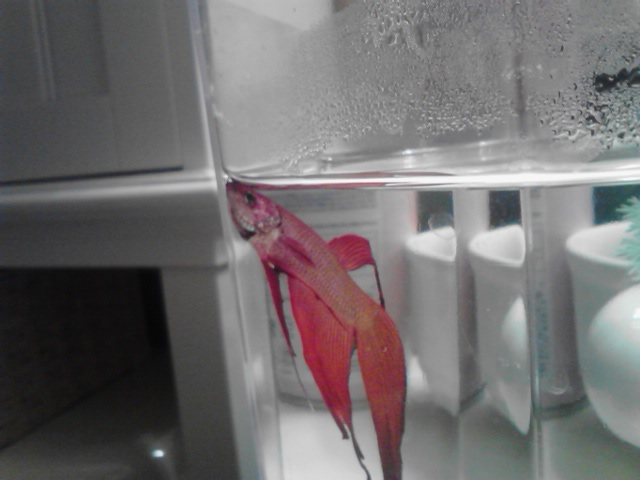 Betta needs help
Question
Flare the Fish Flare 2
I have a r
Betta needs help
Question
Flare the Fish Flare 2
I have a r
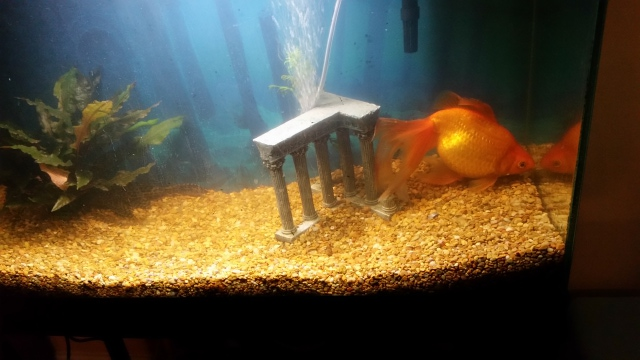 White spots and water issues
Question
Goldfish
I have 2 fish, 1 large fancy g
White spots and water issues
Question
Goldfish
I have 2 fish, 1 large fancy g
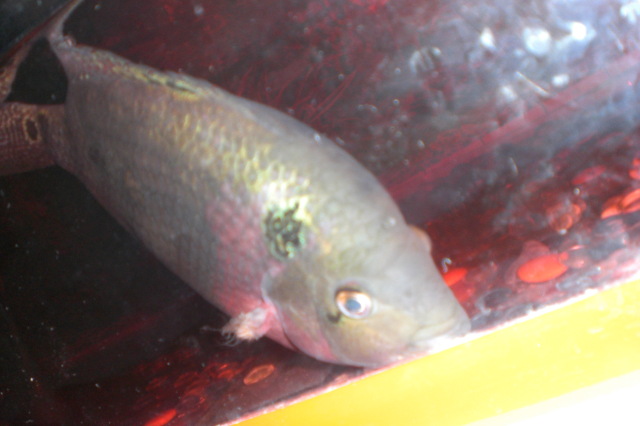 hi (about my flower horn fish)
Question
this is my flowerhorn
hi how are u? im just h
hi (about my flower horn fish)
Question
this is my flowerhorn
hi how are u? im just h
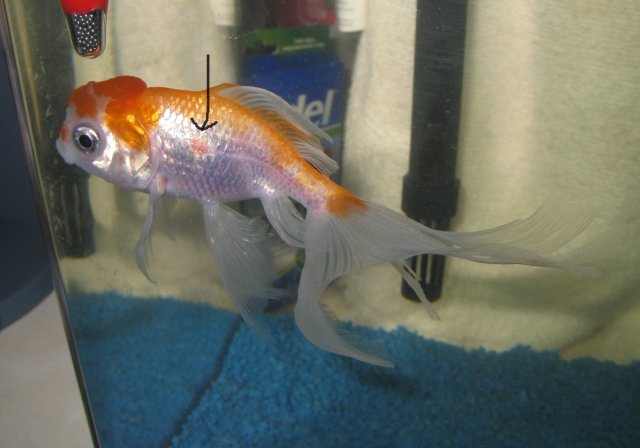 4 yr goldfish red spot
QuestionMy Goldfish
QUESTION: My goldfish sudden
4 yr goldfish red spot
QuestionMy Goldfish
QUESTION: My goldfish sudden
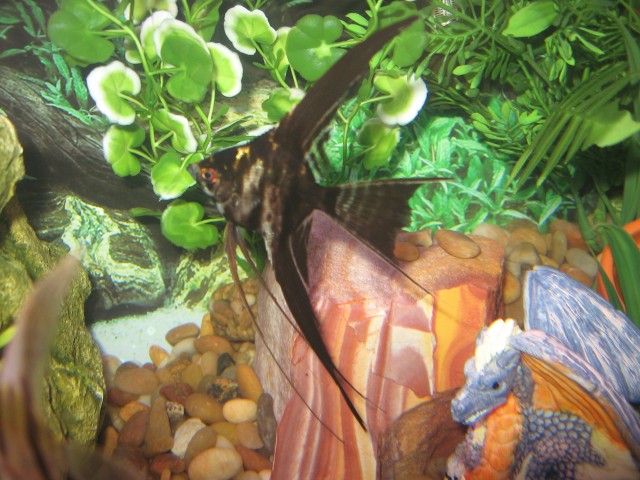 Room for more?
QuestionQUESTION: I got a little carried away last nigh
Room for more?
QuestionQUESTION: I got a little carried away last nigh